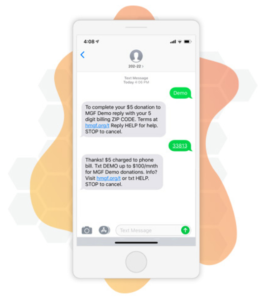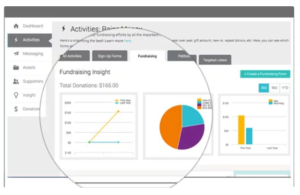Text-to-give campaign fundraising has become incredibly popular with the public’s increasing love for smartphones. And as a nonprofit, how you could pass up the opportunity to capitalize on your supporters’ favorite piece of technology?
There are plenty of skills to master when it comes to your text-to-give campaign, and there’s a lot of information to convey to your donors.
To help you out, we’ve created a list of 7 best practices for your next text-to-give campaign:
If you’re sold on text giving but haven’t selected a provider yet, check out Double the Donation’s Top 12 Text-to-Give Services for Nonprofits. If you’ve chosen a provider and are ready to master your text giving campaign, read on!
1. Keep your shortcode simple.
Each text giving software is different, but many will provide one phone number for all of their clients’ campaigns. The provider clarifies which organization to donate to through a shortcode your supporters will include in their text message.
In other words, your supporters might text “HAPPY20” to 55555 to donate while another organization will have their supporters text “GREEN75” to 55555 to donate to their campaign. The provider sends each donor to the appropriate donation form based on the shortcode used.
The shortcode, simply a string of letters and/or numbers specific to your nonprofit, is crucial in making sure the donation gets to the right organization. You’ll want to keep your nonprofit’s short code simple to maximize your donations.
The longer or more complex the code, the more likely your donors will forget it. Complicated shortcodes also open up possibilities for typos and of course, donation abandonment.
Make a note of your provider’s requirements and find answers to the following questions when creating your shortcode:
- How many characters does the shortcode need to be?
- Can you include special characters in your shortcode?
- Are shortcodes case sensitive?
Keep in mind, your shortcode should be unique, too. Your code should be specific to your nonprofit because generic shortcodes, like “NONPROFIT” or “ANIMALSHELTER,” are most likely already being used by other organizations.
You may want to brainstorm a few shortcode ideas for this reason. Try variations of your organization’s name and cause to come up with the perfect (and relevant!) code.
2. Make your forms straightforward.
 After sending off the initial text, your donors will be directed to a donation form from their text message to complete their transaction. To make sure they follow through with their gift, make sure your donation form is as straightforward as possible.
After sending off the initial text, your donors will be directed to a donation form from their text message to complete their transaction. To make sure they follow through with their gift, make sure your donation form is as straightforward as possible.
Many providers will make these donation forms a separate and simpler version of the online donation form you’ve posted on your nonprofit’s website. These forms are often customizable so you can include things like newsletter registrations.
Don’t require too many required fields, as they will slow down the donation and may turn an easy contribution into a hassle.
Live by the rule of 2 fields of information! Simply require the standard of 2 fields of information, which should be the donor’s name and payment information. Requiring more than 2 fields of information can have a negative impact on your donations as it will slow down your transaction speed.
3. Promote your text giving campaign.
 If they don’t know about your campaign, your supporters can’t donate via text-to-give! Promote your text giving campaign through channels that will reach your mobile supporters.
If they don’t know about your campaign, your supporters can’t donate via text-to-give! Promote your text giving campaign through channels that will reach your mobile supporters.
You can promote your campaign across several platforms:
- Social media
- Promotional t-shirts
- Newsletters
- Flyers
- Print or online advertisements
- Your website
You can even try hosting a contest to encourage mobile giving to your organization. Set high (but attainable) goals with tight deadlines to put some healthy pressure and competition on your donors.
If your donors see you’re approaching your goal with only a few hours left before the fundraiser concludes, they may be more inclined to give more than they would have otherwise.
For example, if your fundraiser ends at 12am but at 11:30pm, Shelly notices you’re $200 away from $5,000, she may splurge and donate the $200 so your organization can reach its goal. You may even exceed your expectations with this tactic if Shelly isn’t the only donor who has this thought process.
No matter what promotional tactics your organization takes, you should always follow a multi-channel marketing approach to reach all audiences because all demographics can be receptive to text-to-give.
4. Instruct your supporters.
Now that you’ve informed your supporters, instruct them on how to make their text-to-give donations. Even if they know about it, they can’t donate if they don’t know how your text-to-give campaign works.
Because text giving is so easy, teaching your supporters how to use it won’t be difficult. There are multiple ways to help walk them through the process.
 Here are some ideas:
Here are some ideas:
- Social media posts. You can tweet, share, and post infographics, pictures, and videos that explain the process. Plus, you can interact with your supporters directly and answer any questions that come up while they’re donating via text giving with tweeting or commenting.
- Flyers. Similar to social media posts, you can put graphics and photos on a flyer to help demonstrate how the text-to-give process works. When supporters have questions about how to donate through text giving, they can refer to the flyer! You can also include the flyer in your email newsletter.
- Live help sessions. You can have a small help session, too. If you have an event coming up or know of a time where you can gather your supporters, you can walk them through the text giving process in person, answering any questions they have right away. You can even live stream your session to reach supporters who can’t make the event!
Most providers have simplified text giving to just a handful of simple steps so your supporters don’t have to be tech savvy to donate! In any case, give them a brief rundown of the steps to eliminate any possible confusion.
5. Offer multiple donation options.
To accommodate for everyone’s budgets and comfort zones, offer multiple donation options with your text giving campaign.
If your only pre-set donation amount is $25, you could be losing a lot of smaller donations and at the same time, turning away donors who would like to contribute more.
Depending on your organization and your supporters, you’ll most likely want to have 4 different giving options, varying in monetary value. You can also include a custom field, so donors don’t have to adhere to your preset amounts if they prefer not to.
You can also provide your donors with the option to become recurring donors, which as you know, simply signs them up to automatically donate on a regular basis. Giving smaller amounts more frequently may be more appealing to some donors than giving one large amount.
Plus, this way, they don’t have to remember to make the donation to your organization every month (or however often they choose to give). They’ll sign up once and give over and over.
Make sure the opportunity to become a recurring donor is visible and clear on your form. It’s quite a popular option and you want to give every donor the opportunity to become even more involved with your organization.
6. Thank your donors.
Donor stewardship is a huge component when it comes to donor retention. Express your gratitude for every donation, no matter how big or small, with emails or letters.

You’ll want to make sure each letter or email is addressed specifically to the donor. You can also inform them of where their specific donation went and how their contribution furthered your project. Give them specific details to prove their support really does help!
Though the donations you receive through text giving may be smaller than your typical donation received elsewhere, remember they’re just as important. Plus, with text-to-give’s ease and simplicity, you may receive more donations than expected, balancing out your monetary gain.
Your thank-you will let your donors know your organization really values their support and this positive customer service can encourage donors to give again!
7. Review your reports.
At your campaign’s conclusion, you’ll most likely turn to your reports and analytics to see how text giving worked for your organization.
The results of your reports will allow you to compare the campaign to previous fundraisers. How well did this text-to-give campaign pay off:
Did your organization reach its monetary goal?
Did you acquire new donors?
Were the bulk of your donations from new donors or existing donors?
What was the most common donation amount?
What’s the average age of the donors who contributed to your text giving campaign?
Depending on how many campaigns you’ve run and how many shortcodes you’ve used, you could also compare different text giving campaigns to each other.
It’s common for providers to help you track your performance from a text giving campaign by making reporting easy and customizable. Be sure you understand how to use the reporting element of your software so you can see your results.
 If, for example, you can integrate your text giving software with your nonprofit CRM, you may be able to see how text giving measures up to your other fundraising strategies and where you can improve on it.
If, for example, you can integrate your text giving software with your nonprofit CRM, you may be able to see how text giving measures up to your other fundraising strategies and where you can improve on it.
Now that you have these 7 best practices for your next text-to-give campaign, you’re sure to see an influx in donations and donor retention. Remember text giving is an easy way to donate so it’s bound to be popular with your supporters, even those who aren’t tech gurus!
Still craving more text-to-give guidance? Take a look at our Text-to-Give Guide.
About the Author.
 Abby Jarvis is a blogger, marketer, and communications coordinator for Qgiv, an online fundraising service provider. Qgiv offers industry-leading online giving and peer to peer fundraising tools for nonprofit, faith-based, and political organizations of all sizes. When she’s not working at Qgiv, Abby can usually be found writing for local magazines, catching up on her favorite blogs, or binge-watching sci-fi shows on Netflix.
Abby Jarvis is a blogger, marketer, and communications coordinator for Qgiv, an online fundraising service provider. Qgiv offers industry-leading online giving and peer to peer fundraising tools for nonprofit, faith-based, and political organizations of all sizes. When she’s not working at Qgiv, Abby can usually be found writing for local magazines, catching up on her favorite blogs, or binge-watching sci-fi shows on Netflix.


![Build a Nonprofit Website that Works [Steal These Ideas!]](https://getfullyfunded.com/wp-content/uploads/2012/09/AdobeStock_260038257-scaled-500x383.jpeg)



Leave A Comment